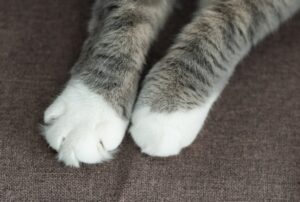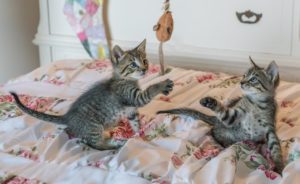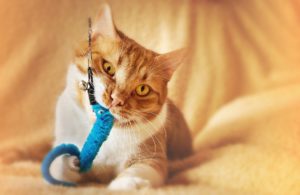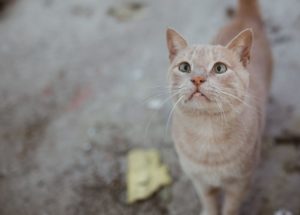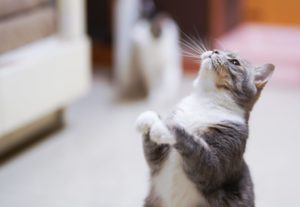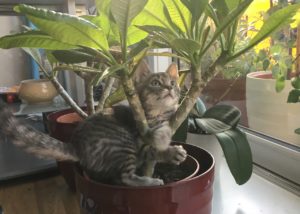Much like with people, it often seems a bit rude to talk about a cat’s weight. However, weight gain in our pets can become quite a problem if not dealt with. While cats do look cute with a bit of extra fur, it can cause health problems further down the line. Some cats are particularly vulnerable to weight problems, putting them at risk. A cat’s diet and exercise has to be monitored if you want to keep them healthy.
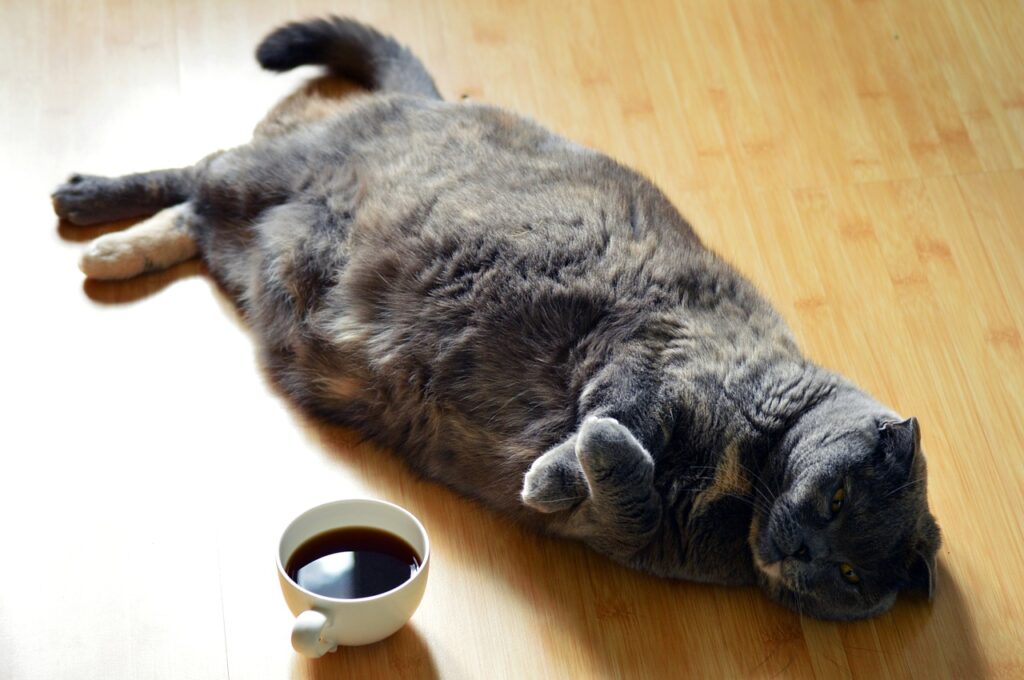
Some cats are more prone to weight gain than others. Some lifestyles make it more common that a cat will gain weight. While dogs have their walks to keep them busy, indoor cats can easily fall into a routine of getting very little exercise. Even cats that do go outside can live a sedentary life, only choosing to lounge in the sun.
If your cat’s weight problem isn’t addressed, it can cause some real health problems and shorten your cat’s lifespan considerably. With so many cats overweight, pet owners should be taking some steps to ensure that they’re doing everything that they can to help any problem with their cat’s weight.
This all starts with the food that they eat. Diet is really important for keeping your cat healthy. A cat’s weight problem might just come down to choice of food or even overfeeding. Their diet has to be adapted to match the type of life style that they have. You can also help your cat by keeping your eye on their exercise and trying to help them get more active throughout the day.
Which Cats are Vulnerable to Weight Gain?
Some cats are particularly vulnerable to weight gain. If your cat fits into one of these at risk categories, you need to be checking your cat’s weight to ensure they’re staying healthy.
Indoor Cat’s Weight
The biggest group at risk is indoor cats. A lot of indoor cats do very little exercise. A cat’s food is usually high in protein. This suits an active cat’s life, and not a cat who is happier sleeping all day. If you have an indoor cat, there is plenty you can do to keep them entertained and even let them get some time outdoors. However, this won’t always be enough to keep them in great shape.
Older Cat’s Weight
Older pets are also at a higher risk of cat weight problems. They are less active than their younger counterparts, which is to be expected as they age. However, if their feeding schedule and food composition doesn’t adapt to their age then they may begin to gain some weight. You should keep an eye on your cat if you’ve begun to notice signs of ageing. They may end up gaining weight as they get older.
Neutered or Spayed Cat’s Weight
Neutering or spaying your cat might be the responsible thing to do, but it will also increase your cat’s risk of developing a weight problem. The metabolism of a cat will slow down after being spayed or neutered. They will also lose some of their instincts to play or exercise. If not treated, these changes in their body could lead to them gaining weight.
Does Your Cat Have a Weight Problem?
If your cat falls into one of those categories, then they are at a much higher risk of developing a weight problem. You should be keeping an eye on your cat’s weight to ensure that they aren’t gaining too much weight. However, the definition of too much weight for a cat is different for different pets. Some pets will be overweight at a different size to others. If your cat is longhaired or built quite stocky, then it can be hard to tell if they’re overweight or just a bigger pet.

Weighing Your Cat
The easiest way to tell if a cat is overweight is to weigh them. Weighing a cat regularly can help you tell if your cat is gaining enough weight for it to be a concern. The simplest way to weigh your cat is to get onto the scales with the pet yourself. While holding them, weigh yourself and your pet and make a note of the weight. You can then put the cat down and weigh yourself. Subtract your weight from the total weight and you will have an exact figure for how much your pet weighs. This method avoids the pitfalls of trying to train a cat to sit still on a scale.
What’s the Right Weight for a Cat?
The perfect weight for a cat is going to vary depending on their breed. If you have a pure breed cat, it will be better for you to look up what the proper weight for that breed is. A large breed like a Maine Coon can weigh up to 25 pounds, and a Siamese can weigh 5. Both of these weights are perfectly healthy. However, for mixed breed cats and most average sized indoor pets a weight of around 10 pounds is a good number. If your pet is quite a bit over this, they might be overweight.
How to Deal with a Cat’s Weight
If your cat has a weight problem, then you will need to help them out a bit. They won’t be changing their lifestyle and diet by themselves. Losing weight can be a struggle for a lot of people, and your cat may struggle too. This is a gradual process though. It is important to keep your cat’s happiness in mind when doing this. A gradual change to get their weight down is much healthier than arbitrarily halving their food intake until they hit a normal weight.
These are some ways you can help with your cat’s weight problem without overloading them with change.
Food
Typically, the main reason why your cat has a weight problem is their food. The first thing you should do is to cut down on treats that may be unhealthy. This means no sharing of your own treats with your cat or giving them leftovers. These types of food can just be calories that a cat can’t actually use. If you’re watching a cat’s weight you need to make sure they’re only eating food that is right for cats.

You should also cut down on cat treats that may be unhealthy. These treats that are just junk food can be removed from your pet’s diet. You should also check the composition of your cat’s main food. There is a lot to consider when choosing a healthy food for your pet. However, if they’re gaining weight you should look to switch them over to a lower-calorie food. Doing this will allow you to continue feeding your cat a healthy amount while cutting down their calories.
You should also make sure you’re feeding your cat proper meals rather than just leaving food out for them to graze on. Consult the pet food you use for the specific meal sizes. Also, don’t forget that this quantity will depend on the specific food brand you are using so always make sure to read the instructions.
Exercise to Deal With a Cat’s Weight
If your cat has a weight problem, it may be because they aren’t getting enough exercise. Even if a cat is eating a normal amount of food, an overly sedentary lifestyle can give them problems with their weight. To combat this, you need to get your cat up and active.

If you have an indoor cat, you can do this by getting them cat furniture to play on. You should then encourage them to engage in active play. Spend some time playing with your cat and make sure they’re getting enough play every day. You can also try using a cat leash to get them out and walking. It isn’t just dogs that can use walking as exercise, it works great for cats too.
You can try putting your cat’s dry food into an active toy that only releases the food as they play. This encourages them to get some exercise by making them work for their food. If you use creative solutions like these, getting your cat some exercise can be a fun process for you both.
Company
A good way for your cat to get more exercise is to have another cat around. Getting a second cat will help keep your cat company, but it will also keep them both active. The two of them will be much more likely to play with each other. This can help if you’re out of the house a lot. It keeps your cat company, and encourages them to still be active even when you’re not around to get them playing. A second cat can have a lot of benefits for your pet, but keeping them active is a really important one.
These solutions should help any pet shed a few pounds. The important thing to keep in mind is to do all of this gradually. Dramatically changing your cat’s life style overnight isn’t going to be a fun experience for anyone. Instead, you should make gradual improvements to their food and encourage them to get moving. This stops them gaining more weight and helps them shed the pounds they’ve put on. You may not see the effects overnight, but taking a more gradual approach is a great way to keep any cat’s weight in check. This way your cat can lose their excess weight without having to go through a crash diet.


